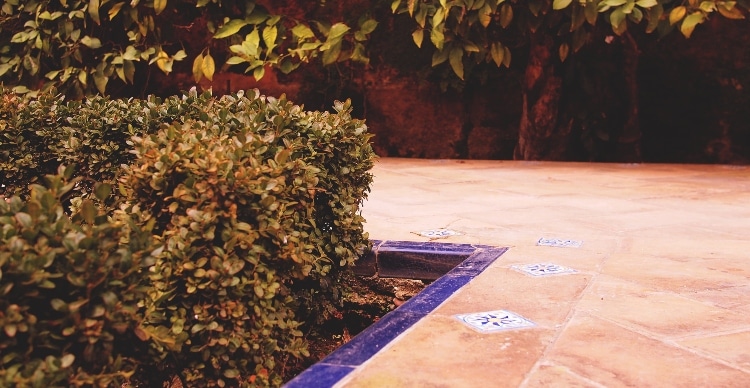
Ready to revamp your landscape design but not sure where to start? Infuse your yard with texture and color by planting ground covers, ornamental grasses, trees and shrubs, and low-maintenance annuals and perennials.
Types of Landscaping Plants
1. Trees

Tree types:
- Evergreen (maintains needles or leaves year-round). Examples of evergreen trees include junipers, spruces, and cypresses.
- Deciduous (loses leaves seasonally, typically during the fall months). Deciduous trees include maples, oaks, and dogwoods.
Advantages: Besides adding diversity to your landscape with various colors and shapes, trees:
- Can live for decades.
- Provide homes for wildlife.
- Reduce noise and air pollution.
- Produce fruits or flowers.
- Offer shade (reducing your energy costs).
- Prevent soil erosion.
Disadvantages:
- Costly to purchase and install.
- Grow slowly.
- Require lots of maintenance — especially fruit trees.
- Need lots of space to mature and spread roots. Without this, roots may disrupt underground utilities and growing branches may interfere with power lines.
2. Shrubs

Shrub types:
- Evergreen (maintains needles or leaves year-round). Examples of evergreen shrubs include boxwoods and azaleas.
- Deciduous (loses leaves seasonally, typically during the fall months). Deciduous shrubs include forsythia bushes and rhododendrons.
Advantages: These woody plants are often used as foundation plantings and can create living fencing for privacy. In addition some shrubs:
- Can block against heavy winds (think mugo pines and yews).
- Reduce noise and air pollution.
- Provide food and shelter for wildlife.
- Prevent soil erosion.
Disadvantages:
- Needledrop, which happens throughout the year with evergreen types, can lead to more yard and garden cleanup.
- Can grow too quickly and cause damage to foundation.
- May require a lot of time to shape and trim.
- Can be difficult to remove when you’re ready to switch out these plants with updated options.
3. Succulents

Succulent types: Of the more than 60 plant families that make up succulents, popular types include:
- Sedum
- Sempervivum
- Echeveria
- Cacti
- Kalanchoe
- Ice plant
- Aloe
Advantages: Drought-resistant and low-maintenance, succulents also:
- Have medicinal value (depending on type)
- Improve air quality, according to experts
- Boost your mood and lower stress
- Are not very susceptible to diseases and pests
- Do well with container gardening
- Add color and texture to rock gardens
Disadvantages: Some succulents have sharp spikes, so be careful not to plant these as walkway edgers or in kids’ play areas.
4. Flowering plants

Flower types: Besides trees and some succulents and shrubs, other flowering plants include perennial and annual plants:
- Hibiscus plants
- Dianthus
- Gardenias
- Geraniums
- Begonias
- Peonies
- Petunias
- Daffodils
Advantages: Like other plants, flowering ones also:
- Help purify the air and provide oxygen.
- Boost your mood and lower stress.
- Help you get exercise (taking care of flower beds).
- Add color and texture to landscaping.
- Provide cut flowers for interior decor.
- Attract pollinators, such as bees and butterflies.
- Come back on their own year after year (if perennials).
- Provide immediate color (if annuals).
Disadvantages:
- Annual plants must be set out each year, meaning more expenses and care.
- Perennials have a short growing season.
5. Desert landscaping plants

Desert plant types: When it comes to desert landscaping, succulents and cacti aren’t the only options. Consider:
- Trees, such as palm and desert willow.
- Ground covers, such as trailing rosemary and salvia.
- Shrubs, such as barberry and cape honeysuckle.
- Vines, such as lilac vine and grape ivy.
- Ornamental grasses, such as bamboo muhly and blue grama.
- Perennials, such as desert marigold and autumn sage.
- Annuals, such as red flax and Mexican sunflower.
Advantages: Especially when native to the growing area, these plants:
- Are adapted to local climate and soil conditions.
- Require less water and fertilizer.
- Are less prone to pests and diseases.
- Low-maintenance, eco-friendly, and take less money to care for.
Disadvantages: Going dormant is what helps keep these plants drought-resistant. However, dormancy can make your landscape appear dead and colorless. Experts suggest avoiding this by choosing plants with various blooming seasons and surrounding them with additional points of interest, such as rocks, statues, and other hardscapes.
6. Aquatic plants

Aquatic plant types:
- Planktonic algae
- Floating plants (water lilies and lotuses)
- Emergent plants (cattails and bulrushes)
Advantages: If a pond or water garden is a part of your landscaping, consider adding aquatic plants to the mix. They provide the following for wildlife, such as birds and fish:
- Food
- Shelter
- Nesting habitats
- Shade
Disadvantages: Left to their own devices, the algae and floating and emergent plant types can:
- Overspread.
- Disrupt water quality.
- Mess with oxygen production, potentially leading to fish death.
7. Ground covers

Ground cover types:
- Dianthus
- Clematis
- Hosta
- Deer-resistant hellebore
- Sedge, can double as ground cover and ornamental grass
Advantages: Replacing your grassy lawn with a ground cover makes things low-maintenance — you won’t have to worry about mowing. Ground covers are also a good substitute for plants that can’t grow in full sun or in shade gardens, as certain ground covers do well in either. Ground covers prefer moist soil; other benefits include:
- Erosion and weed control.
- Textural balance in garden design.
- Cold hardiness (depending on type).
Disadvantages: Be careful when selecting ground covers, as some can become invasive. Prune occasionally to keep them in check. Some varieties are also susceptible to disease and pests.
When to Call a Landscaping Pro
Need help selecting different plants for your climate and soil? Overwhelmed by all the information on growing and maintaining even low-maintenance landscape designs? Get help from your local landscaping experts. They’ll help elevate your yard’s aesthetics by customizing a layout for your garden beds and overall terrain.
Main Photo: Pxfuel